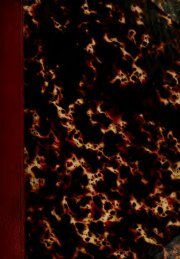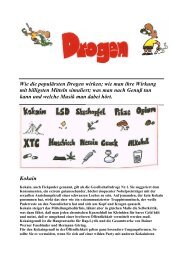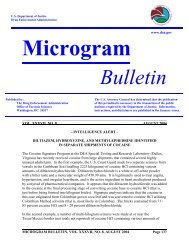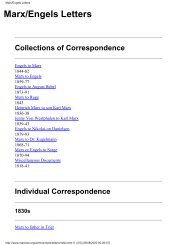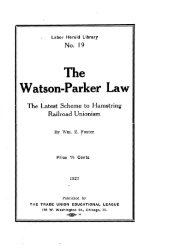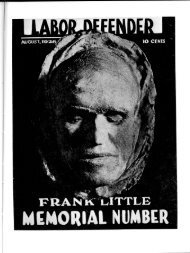MOURA Dinara Jaqueline et al.
MOURA Dinara Jaqueline et al.
MOURA Dinara Jaqueline et al.
You also want an ePaper? Increase the reach of your titles
YUMPU automatically turns print PDFs into web optimized ePapers that Google loves.
8. Boeira, J. M., Viana, A. F., Picada, J. N. and Henriques, J. A. P. (2002)<br />
Genotoxic and recombinogenic activities of the two b<strong>et</strong>a-carboline <strong>al</strong>k<strong>al</strong>oids<br />
harman and harmine in Saccharomyces cerevisiae. Mutat. Res., 500, 39–48.<br />
9. Tse, S. Y. H., Mak, I. T. and Dickens, B. F. (1991) Antioxidative properties<br />
of harmane and b-carboline <strong>al</strong>k<strong>al</strong>oids. Biochem. Pharmacol., 42, 459–464.<br />
10. Rommelspacher, H., May, T. and S<strong>al</strong>ewski, B. (1994) Harman (1-m<strong>et</strong>hylb<strong>et</strong>a-carboline)<br />
is a natur<strong>al</strong> inhibitor of monoamine oxidase type A in rats.<br />
Eur. J. Pharmacol., 252, 51–59.<br />
11. Kim, H., Sablin, S. O. and Ramsay, R. R. (1997) Inhibition of monoamine<br />
oxidase A by b-carboline derivates. Arch. Biochem. Biophys., 337, 137–142.<br />
12. Herraiz, T. and Chaparro, C. (2005) Human monoamine oxidase is<br />
inhibited by tobacco smoke: b-carboline <strong>al</strong>k<strong>al</strong>oids act as potent and<br />
reversible inhibitors. Biochem. Biophys. Res. Commun., 326, 378–386.<br />
13. Pimpinella, G. and P<strong>al</strong>mery, M. (1995) Interaction of b-carbolines with<br />
centr<strong>al</strong> dopaminergic transmission in mice: structure-activity relationships.<br />
Neurosci. L<strong>et</strong>t., 189, 121–124.<br />
14. Grella, B., Dukat, M., Young, R., Teitler, M., Davis, K. H., Gauthier, C. B.<br />
and Glennon, R. A. (1998) Investigation of h<strong>al</strong>lucinogenic and related bcarbolines.<br />
Drug Alcohol Depend., 50, 99–107.<br />
15. Glennon, R. A., Dukat, M., Grella, B. <strong>et</strong> <strong>al</strong>. (2000) Binding of b-carbolines<br />
and relating agents at serotonin (5-HT2 and 5-HT1A), dopamine (D2) and<br />
benzodiazepines receptors. Drug Alcohol Depend., 60, 121–132.<br />
16. Husbands, S. M., Glennon, R. A., Gorgerat, S., Gough, R., Tyacke, R.,<br />
Nutt, D. J., Lewis, J. W. and Hudson, A. L. (2001) b-Carboline binding to<br />
imidazole receptors. Drug Alcohol Depend., 64, 203–208.<br />
17. Squires, E. P., Hills, C. E., Rogers, G. J., Garland, P., Farley, S. R. and<br />
Morgan, N. G. (2004) The putative imidazoline receptor agonist, harmane,<br />
promotes intracellular c<strong>al</strong>cium mobilization in pancreatic b-cells. Eur.<br />
J. Pharmacol., 501, 31–39.<br />
18. Loew, G. H., Nienow, J., Lawson, J. A., Toll, L. and Uyeno, E. T. (1985)<br />
Theor<strong>et</strong>ic<strong>al</strong> structure-activity studies of b-carbolines an<strong>al</strong>ogs. Requirements<br />
of benzodiazepine receptor affinity and antagonist activity. Mol. Pharmacol.,<br />
28, 17–31.<br />
19. Barbaccia, M. L., Ravizza, L. and Costa, E. (1986) Maprotiline: an antidepressant<br />
with an unusu<strong>al</strong> pharmacology profile. J. Pharmacol. Exp. Ther.,<br />
236, 307–312.<br />
20. Fuller, R. W., Wong, C. J. and Hemrick-Luecke, S. K. (1986) MD240928<br />
and harm<strong>al</strong>ine: opposite selectivity in antagonism of the inactivation of<br />
types A and B monoamino oxidase by paragyline in mice. Life Sci., 38,<br />
409–412.<br />
21. Taira, Z., Kansawas, S., Dohara, C., Ishida, S., Matsumoto, M. and<br />
Ohsawa, M. (1997) Interc<strong>al</strong>ation of six b<strong>et</strong>a-carboline derivatives into<br />
DNA. Jpn. J. Toxicol. Environ. He<strong>al</strong>th, 43, 83–91.<br />
22. B<strong>al</strong>on, M., Munoz, M. A., Carmona, C., Guardado, P. and G<strong>al</strong>an, M.<br />
(1999) A fluorescent study of the molecular interactions of harmane with<br />
the nucleobases, their nucleosides and mononucleotides. Biophys. Chem.,<br />
80, 41–52.<br />
23. Funayama, Y., Nishio, K., Wakabayashi, K., Nagao, M., Shimoi, K.,<br />
Ohira, T., Hasegawa, S. and Saijo, N. (1996) Effects of b-and c-carboline<br />
derivatives on DNA topoisomerases activities. Mutat. Res., 349, 183–191.<br />
24. Wehner, F. C., Thiel, P. G. and Van Rensburg, S. J. (1979) Mutagenicity of<br />
<strong>al</strong>k<strong>al</strong>oids in the S<strong>al</strong>monella/microsome systems. Mutat. Res., 66, 187–190.<br />
25. Oda, Y., Nakamura, S. I. and Oki, I. (1988) Harman and norharman induces<br />
SOS responses and frameshift mutation in bacteria. Mutat. Res., 208, 39–44.<br />
26. Picada, J. N., Silva, K. V. C. L., Erdtmann, B., Henriques, A. T. and<br />
Henriques, J. A. P. (1997) Genotoxic effects of structur<strong>al</strong>ly related ßcarboline<br />
<strong>al</strong>k<strong>al</strong>oids. Mutat. Res., 379, 135–149.<br />
27. Nakayasu, M., Nakasato, F., Sakamoto, H., Terada, M. and Sugimura, T.<br />
(1987) Mutagenic activity of norharman and harman in Chinese lung cells in<br />
assay with diphteria toxin resistance as a marker. Cancer L<strong>et</strong>t., 17, 249–255.<br />
28. Boeira, J. M., Silva, J., Erdtmann, B. and Henriques, J. A. P. (2001)<br />
Genotoxic effects of the <strong>al</strong>k<strong>al</strong>oids harman and harmine by com<strong>et</strong> assay and<br />
chromosome aberration test in mamm<strong>al</strong>ian cells in vitro. Pharmacol.<br />
Toxicol., 89, 287–294.<br />
29. Madle, E., Obe, G., Hansen, J. and Ristow, H. (1981) Harman and<br />
norharman: induction of sister-chromatid exchanges in human peripher<strong>al</strong><br />
lymphocytes in vitro and interaction with isolated DNA. Mutat. Res., 90,<br />
433–442.<br />
30. Wakabayashi, K., Yahagi, T., Nagao, M. and Sugimura, T. (1982) Comutagenic<br />
effect of norharman with amino pyridine derivatives. Mutat.<br />
Res., 105, 205–210.<br />
31. Sasaki, Y. F. and Shirasu, Y. (1993) Suppressing effects of S phase posttreatment<br />
with carbolines on sister-chromatid exchange induced by mitomycin<br />
C in Chinese hamster cells. Mutat. Res., 302, 165–171.<br />
32. Sasaki, Y. F., Yamada, H., Símio, K., Kinae, N., Tomita, I., Matsumura, H.,<br />
Ohta, T. and Shirasu, Y. (1992) Enhancing effects of h<strong>et</strong>erocyclic amines<br />
Antioxidant properties of b-carboline <strong>al</strong>k<strong>al</strong>oids<br />
and b-carbolines on the induction of chromosome aberration in culture<br />
mamm<strong>al</strong>ian cells. Mutat. Res., 269, 79–95.<br />
33. Cho, I. S., Shin, Y. K. and Lee, C. S. (1995) Effects of harm<strong>al</strong>ine and<br />
harm<strong>al</strong>ol on the oxidative injuries of hy<strong>al</strong>uronic acid, lipid and collagen by<br />
Fe 2þ and H2O2. Korean J. Pharmacol., 31, 345–353.<br />
34. Kim, H. H., Jang, Y. Y., Han, E. S. and Lee, C. S. (1999) Differenti<strong>al</strong><br />
antioxidant effects of ambroxol, rutin, glutathione and harm<strong>al</strong>ine. J. Appl.<br />
Pharmacol., 7, 112–120.<br />
35. Maher, P. and Davis, J. B. (1996) The role of monoamine m<strong>et</strong>abolism in<br />
oxidative glutamate toxicity. J. Neurosci., 16, 6394–6401.<br />
36. Lee, C. S., Han, E. S., Jang, Y. Y., Han, J. H., Ha, H. W. and Kim, D. E.<br />
(2000) Protective effect of harm<strong>al</strong>ol and harm<strong>al</strong>ine on MPTP neurotoxicity<br />
in the mouse and dopamine-induced damage of brain mitochondria and<br />
PC12 cell. J. Neurochem., 75, 521–531.<br />
37. Kim, D. H., Jang, Y. Y., Han, E. S. and Lee, C. S. (2001) Protective effect<br />
of harm<strong>al</strong>ine and harm<strong>al</strong>ol against dopamine and 6-hydroxydopamineinduced<br />
oxidative damage of brains mitochondria and synaptosomes, and<br />
viability loss of PC12 cells. Eur. J. Neurosci., 13, 1861–1872.<br />
38. Park, T. H., Kwon, O. S., Park, S. Y., Han, E. S. and Lee, C. S. (2003) Nm<strong>et</strong>hylated<br />
b-carbolines protect PC12 cells from cytotoxic effects of MPPþ<br />
by attenuation of mitochondri<strong>al</strong> membrane permeability change. Neurosci.<br />
Res., 46, 349–358.<br />
39. Wiseman, H. and H<strong>al</strong>liwell, B. (1996) Damage to DNA by reactive oxygen<br />
and nitrogen species: role in inflammatory disease and progression to<br />
cancer. Biochem. J., 313, 17–29.<br />
40. Stadtman, E. R. and Berl<strong>et</strong>t, B. S. (1997) Reactive oxygen-mediated protein<br />
oxidation in aging and disease. Chem. Res. Toxicol., 10, 485–494.<br />
41. V<strong>al</strong>ko, M., Izakovic, M., Mazur, M., Rhodes, C. J. and Telser, J. (2004)<br />
Role of oxygen radic<strong>al</strong>s in DNA damage and cancer incidence. Mol. Cell.<br />
Biochem., 266, 37–56.<br />
42. Borek, C. (2001) Antioxidant he<strong>al</strong>th effects of aged garlic extract.<br />
Nutrition, 131, 1010S–1015S.<br />
43. Zhang, W., Guo, Y. W. and Gu, Y. (2006) Secondary m<strong>et</strong>abolites from the<br />
South China Sea invertebrates: chemistry and biologic<strong>al</strong> activity. Curr.<br />
Med. Chem., 13, 2041–2090.<br />
44. Burke, D., Dawson, D. and Stearns, T. (2000) M<strong>et</strong>hods in Yeast Gen<strong>et</strong>ics.<br />
Cold Spring Harbor Laboratory Course Manu<strong>al</strong>. CSH Laboratory Press,<br />
Plainview, New York, pp 171–205.<br />
45. Longo, V. D., Gr<strong>al</strong>la, E. B. and V<strong>al</strong>entine, J. S. (1996) Superoxide<br />
dismutase activity is essenti<strong>al</strong> for stationary phase surviv<strong>al</strong> in Saccharomyces<br />
cerevisiae. J. Biol. Chem., 271, 12275–12280.<br />
46. Cyrne, L., Martins, L., Fernandes, L. and Marinho, H. S. (2003) Regulation<br />
of antioxidant enzymes gene expression in the yeast Saccharomyces<br />
cerevisiae during stationary phase. Free Radic. Biol. Med., 34, 385–393.<br />
47. Brendel, M., Grey, M., Maris, A. <strong>et</strong> <strong>al</strong>. (1988) Low glutathione pools in the<br />
origin<strong>al</strong> pso3 mutant of Saccharomyces cerevisiae are responsible for its<br />
pleiotropic sensitivity phenotype. Curr. Gen<strong>et</strong>., 33, 4–9.<br />
48. Whelan, W. L., Gocke, E. and Manney, T. R. (1979) The CAN1 locus of<br />
Saccharomyces cerevisiae: fine-structure an<strong>al</strong>ysis and forward mutation<br />
rates. Gen<strong>et</strong>ics, 91, 35–51.<br />
49. Speit, G., Habermeier, B. and Helbig, R. (1994) Differences in the<br />
responses to mutagens b<strong>et</strong>ween two V79 sublines. Mutat. Res., 325,<br />
105–111.<br />
50. Singh, N. P., McCoy, M. T., Tice, R. R. and Schneider, E. L. (1998) A<br />
simple technique for quantification of low levels of DNA damage in<br />
individu<strong>al</strong> cell. Exp. Cell Res., 175, 184–191.<br />
51. Hartmann, A. and Speit, G. (1997) The contribution of cytotoxicity to<br />
DNA-effects in the single cell gel test (com<strong>et</strong> assay). Toxicol. L<strong>et</strong>t., 90,<br />
183–188.<br />
52. Nadin, S. B., Vargas-Roig, L. M. and Ciocca, D. R. (2001) A silver staining<br />
m<strong>et</strong>hod for single-cell gel assay. J. Histochem. Cytochem., 49, 1183–1186.<br />
53. Tice, R. R., Agurell, E., Anderson, D <strong>et</strong> <strong>al</strong>. (2000) Single cell gel/com<strong>et</strong><br />
assay: guidelines for in vitro and in vivo gen<strong>et</strong>ic toxicology testing.<br />
Environ. Mol. Mutagen., 35, 206–221.<br />
54. Collins, A. R. (2004) The com<strong>et</strong> assay for DNA damage and repair:<br />
principles, applications, and limitations. Mol. Biotechnol., 26, 249–261.<br />
55. Owen, R. W., Wimonwatwatee, T., Spiegelh<strong>al</strong>der, B. and Bartsch, H.<br />
(1996) A high performance liquid chromatography m<strong>et</strong>hod for quantification<br />
of hydroxyl radic<strong>al</strong> formation by d<strong>et</strong>ermination of dihydroxy benzoic<br />
acids. Eur. J. Cancer Prev., 5, 233–240.<br />
56. Owen, R. W., Haubner, R., Mier, W., Giacosa, A., Hull, W. E.,<br />
Spiegelh<strong>al</strong>der, B. and Bartsch, H. (2003) Isolation, structure elucitation<br />
and antioxidant potenti<strong>al</strong> of the major phenolic and flavonoid compounds in<br />
brined olive drupes. Food Chem. Toxicol., 41, 703–717.<br />
57. H<strong>al</strong>liwell, B. and Gutteridge, J. M. C. (2000) Free Radic<strong>al</strong>s in Biology and<br />
Medicine. 3rd ed. Oxford University Press, New York.<br />
301<br />
Downloaded from<br />
mutage.oxfordjourn<strong>al</strong>s.org by guest on May 16, 2011



